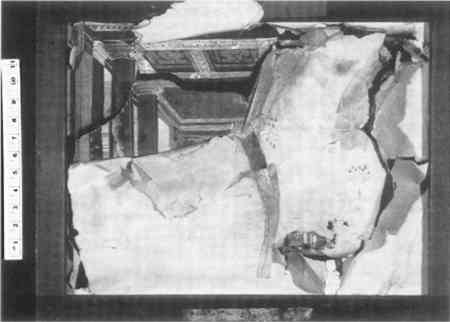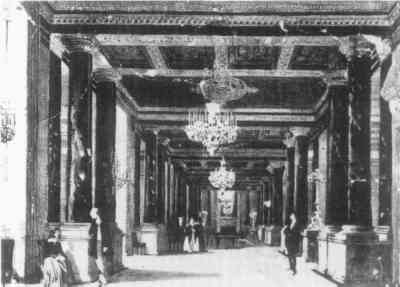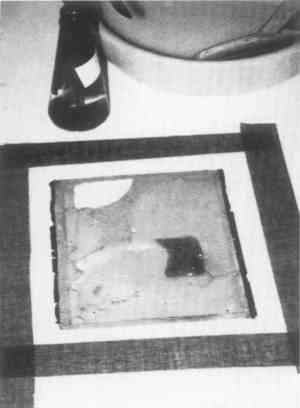A CONSERVATION CASE STUDY OF POLYRAMA PANOPTIQUE PAPER VIEWING SLIDESTED STANLEY
5 SECOND TREATMENT EXAMPLE: THE GRAND HALL5.1 EXAMINATION AND CONDITIONThe title of the second treatment example (figs. 12a, 12b) is unknown, for the manuscript label on the verso of the strainer was so badly damaged that the handwriting was obscured and ultraviolet fluorescent illumination was of no help. The author refers to this slide as The Grand Hall since it depicts a grand hall with chandeliers overhead and a few figures of people. It is a hand-colored lithograph. The artist and date of execution are unknown, but it was most likely produced at about the same time as the Rue de Rivoli slide, as the construction features and materials are the same and the sizes of the individual components are all about the same. The primary support measures 17.5 cm high � 23.5 cm wide. The secondary support measures 18.5 cm high � 22.5 cm wide. Some images of light sources, such as the chandeliers, have perforations and slits in the paper support to bring them into play in transmitted light.
The Grand Hall slide was even more damaged than the Rue de Rivoli slide. The damage was especially severe to the secondary support, which had a large loss, constituting approximately one-sixth of the support. There were also massive tears of both the primary and secondary supports, some appearing gapped in addition to creased and folded. A grayish stain appeared along the edges of some tears. Glassine tape, deteriorated and very brown, had been used to repair the verso of the primary support and the recto of the secondary support. The cloth tab was missing from the verso of the strainer. The paper cover anchor for the tab was severely damaged with a large loss. Yet the watercolor was in very good condition. As with Rue de Rivoli, the color remained vibrant with little or no apparent abrasion or other damage to the pigment. Testing found that the watercolor of the primary support was somewhat stable in water. The watercolor of the secondary support was very stable in water. 5.2 TREATMENT STRATEGY AND IMPLEMENTATIONA more complex conservation strategy was required in this case than in the first treatment example because of the extensive damage to 5.2.1 REMOVING THE SUPPORTS AND GLASSINE TAPE REINFORCEMENTSTemplates were created before removal of the supports to be used in monitoring the course of the support repair. The templates were made on clear sheets of polyester film using a permanent marker pen. After testing various alternative methods, the task of removing the supports and former repairs proceeded in the same manner as that of the first treatment example. The damp blotter and tacking iron technique successfully removed the supports without incident. Gore-Tex damp packs removed the former glassine tape repairs. In one instance of removing a glassine tape repair located on the verso of the primary support, a portion of a very thin reddish wash that was located under the tape was unavoidably lifted. The affected area could be seen on the support in transmitted light. Various techniques were tried without success to prevent the loss of the wash. It became apparent that the wash was solubilized when the glassine tape was applied and a portion of the wash transferred to the tape carrier. The phenomenon of pigment transfer is fairly common in attempts to reverse old reinforcements and repairs such as tapes and linings. Dry cleaning of the support surface was not necessary because of the absence of surface dirt and dust. Removal of the primary support revealed the image of the recto of the secondary support underneath, which featured a large block of cadmium red wash with a small block of dark wash positioned within it. The image on the verso of the primary support is much like the recto of the secondary support (fig. 13). Only detail and extensive coloring are lacking.
5.2.2 STABILIZING THE SUPPORTSBefore the repair, the primary support was washed in a 65:35 water-alcohol bath to reduce the staining. Water-alcohol washing also avoided the risk of the watercolor's becoming soluble. Washing objects that have moisture-sensitive pigments in water-alcohol solutions has proven to be a very safe method over the years (Gettens and Stout [1942] 1966). Techniques such as blotter washing are risky for treating supports with soluble pigments, as the capillary action of the blotter may well draw or sink the pigment into the support. In the case of paper viewing slides, there is pigment on both sides of the support, so there is the risk that the pigment adjacent to the blotter will be drawn off or migrate into the blotter on one side and that the pigment on the other side will be drawn into the object's support. The primary support was repaired in the same manner as the first repair treatment using adhesive to join tears and pulp fills to repair gaps in the tears. The primary support was then lightly humidified in a chamber and placed between blotter, felts, and weights for flattening. An inspection afterward found that it shrank about 1 mm horizontally and about 2 mm vertically. The shrinkage may have been due to several factors, such as the repair of the tears, which pulled in the support; some initial shrinkage as the support came off the strainer; or perhaps the effect of washing the support. Repairing the secondary support was a problematic venture. In addition to a very large loss, the secondary support was severely damaged with tears. Therefore, a very simple and direct method of repair was needed. It was also imperative that the paper to be used for the infill have the same light transmission characteristics as the support paper when seen in transmitted light. A French stretch lining technique provided an easy and controllable method of repairing the severely damaged secondary support (fig. 14). This method, which is used at the Biblioth�que
The secondary support was washed for about 15 minutes in a deionized water bath with the pH raised to 7.5 using calcium hydroxide, then air-dried and examined. The support lightened only slightly, and there was no change in appearance of the watercolor wash. Next the support was prepared for the lining procedure by rewetting it in a water bath. Then, preparations for the lining proceeded by laying down a 5 mil sheet of well-sanded clear polyester film (with the sanded side up) onto a sheet of plate glass that had been thoroughly wetted. Sanding the polyester film prevents the surface of the adhesive-soaked lining paper from ferrotyping when it dries. The plate glass would allow infilling of the support to be performed later on a light table. The polyester sheet was pressed to the surface of the glass with a squeegee to produce good overall contact and remove the air pockets between the film and ground surface. Next, W-1 tengucho Japanese paper, rough side up, was brushed onto the sanded polyester film with dilute wheat starch paste. The wheat starch paste expanded the Japanese paper to about the exact equivalent of the polyester film. The secondary support was then placed on the Japanese paper in a dampened and expanded state. The support tears were properly aligned and then compared against the previously made template of the secondary support to assure that the overall shape of the support was correct. Next, good overall contact of the secondary support to the Japanese paper was established by carefully burnishing the support with a bone folder. A sheet of Reemay covered the support as it was being burnished. Next, 3 in. wide linen strips cut from a bolt of cloth and brushed with wheat starch paste adhered the Japanese paper and sanded polyester film to the glass. The object was then allowed to air-dry. Linen strips are excellent for restraining strips because linen expands and contracts in much the same way as paper. Therefore, it can move in unison with the object and Japanese paper during the drying phase of the lining. After drying the lining, a number of papers
Then, to produce the fill, an insert was cut and adhered to the support with dry wheat starch paste. This step was also performed on a light table, and light transmission readings were checked again because paste can sometimes darken paper. The readings remained unchanged. Tears that had to remain gapped during the lining procedure were pulp-filled and inpainted with pastel. After all the repairs were completed, the secondary support was removed from the sanded polyester film and glass by removing the linen tape, removing the film with lining still attached, and peeling the Japanese paper away from the sanded polyester film. The excess lining was trimmed from the support with a sharp scalpel. The supports were reattached to the strainer with a 1:1 mixture of wheat starch paste and a 3% aqueous solution of Methocel A4M methyl cellulose brushed along the edges of the strainer (fig. 16), which permitted correct positioning of the support on the strainer before it dried. The pigment residue markings and templates were employed as guides in positioning the supports. Next, the Strathmore bond paper was toned with Liquitex ivory black acrylic paint and adhered with wheat starch along the bottom of the primary support to compensate for the shrinkage previously mentioned (figs. 17a, 17b). A replacement tab of linen, sympathetic in appearance, was attached to the strainer where the original linen tab was missing. The loss in the blue paper that had covered the original tab was compensated for by using mino-kozo Japanese paper toned with Talens ultramarine watercolor and adhered with wheat starch paste. The slide was then placed in the show box and examined for its appearance (fig. 18). The treatment was a success. |





